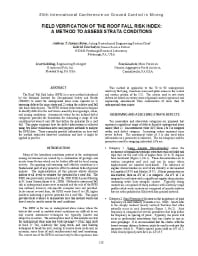Mining Publication: Field Verification of the Roof Fall Risk Index: a Method to Assess Strata Conditions
Original creation date: August 2006
Authors: AT Iannacchione, GS Esterhuizen, SR Schilling, T Goodwin
NIOSHTIC2 Number: 20030807
Proceedings of 25th International Conference on Ground Control in Mining, August 1-3, 2006, Morgantown, West Virginia. Peng SS, Mark C, Finfinger G, Tadolini S, Khair AW, Heasley K, Luo Y, eds., Morgantown, WV: West Virginia University, 2006 Aug; :128-137
The Roof Fall Risk Index (RFRI) is a new method introduced by the National Institute for Occupational Safety and Health (NIOSH) to assist the underground stone mine operator in 1) assessing defects the mine strata and 2) rating the relative roof fall risk these defects pose. The RFRI utilizes observational techniques to identify defects in the roof strata caused by local geologic, stress, and mining conditions. Assessment values for ten defined defect categories provides the foundation for estimating a range of risk conditions between 0 and 100 that define the potential for a roof fall. This paper examines how the defect information is collected using two field verification sites and proposes methods to analyze the RFRI data. These examples provide information on how well the method replicates observed conditions and how it might be applied in practice.

NIOSHTIC2 Number: 20030807
Proceedings of 25th International Conference on Ground Control in Mining, August 1-3, 2006, Morgantown, West Virginia. Peng SS, Mark C, Finfinger G, Tadolini S, Khair AW, Heasley K, Luo Y, eds., Morgantown, WV: West Virginia University, 2006 Aug; :128-137
- Analysis of Pillar Design Practices and Techniques for U.S. Limestone Mines
- Assessing Roof Fall Hazards for Underground Stone Mines: A Proposed Methodology
- A Computer Software Program that Estimates Air Quantity Requirements in Large Opening Stone Mines
- An Evaluation of Microseismic Activity Associated with Major Roof Falls in a Limestone Mine: a Case Study
- Field Observations and Numerical Studies of Horizontal Stress Effects on Roof Stability in U.S. Limestone Mines
- Investigation of Pillar-Roof Contact Failure in Northern Appalachian Stone Mine Workings
- Preventing Injuries Caused by Unrecognized Stone Mine Roof Beam Failures With a Pro-Active Roof Control Plan
- Roof and Rib Hazard Assessment for Underground Stone Mines
- Technique to Assess Hazards in Underground Stone Mines: the Roof Fall Risk Index (RFRI)
- Technology News 520 - A Method to Characterize Risk Associated With Mine Roof Conditions